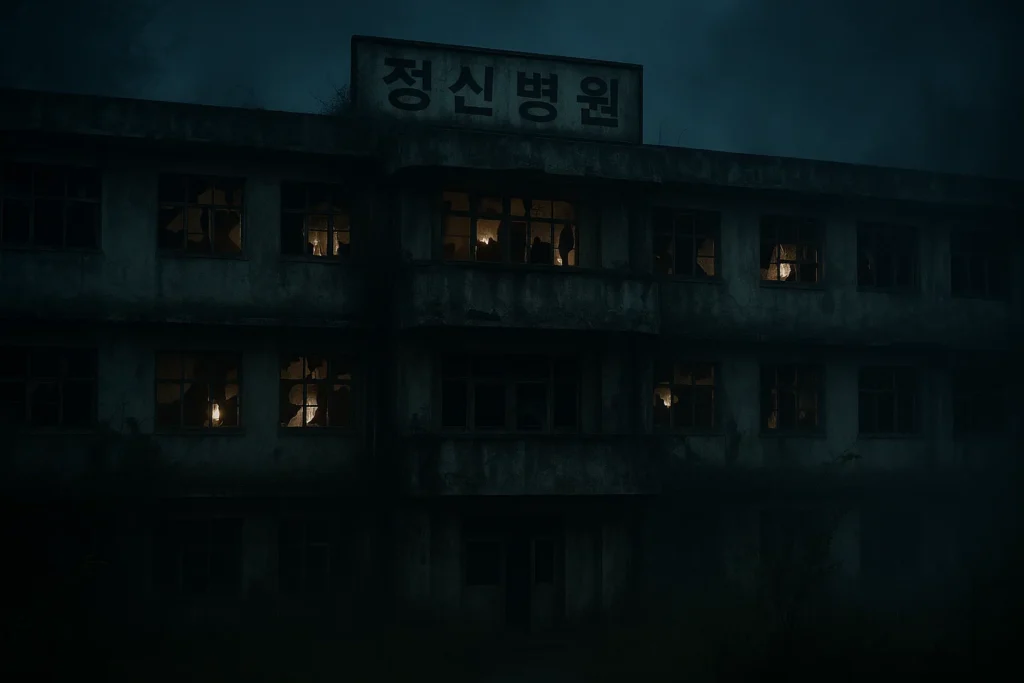
Let’s explore what really went down in the Gonjiam Psychiatric Hospital, why it was abandoned, and how it became one of the most talked-about haunted places in Asia.
The Real Gonjiam Psychiatric Hospital
Long before the movie made it famous, the Gonjiam Psychiatric Hospital stood quietly in Gwangju, Gyeonggi Province, South Korea. It wasn’t some movie set. It was a real mental hospital opened sometime in the 1960s or early 1970s.
For years, it treated psychiatric patients, but around the mid-1990s, the facility was suddenly abandoned overnight. Beds were left unmade. Medical charts remained scattered. Supplies still sat on shelves, as if the staff had vanished into thin air.
Locals began whispering that something horrible had happened.
Rumors spread like wildfire some said patients mysteriously died, others believed the hospital director went insane and disappeared. The truth, as it turns out, is a mix of reality, mystery, and urban legend.
Why Was Gonjiam Asylum Closed?
Let’s tackle the big question why did Gonjiam close?
According to verified reports, the hospital was shut down due to unsanitary conditions and financial problems. The facility allegedly failed multiple health inspections, and the owner fled the country after being charged with mismanagement.
But that’s only part of the story.
Many locals still believe something darker happened there. Tales of patients dying under mysterious circumstances and unreported deaths started to spread through the nearby village. By the early 2000s, the building had turned into a magnet for thrill seekers, ghost hunters, and daredevils looking to experience Korea’s version of the “haunted asylum.”
How Many People Died in Gonjiam?
There are no official records of mass deaths or murders inside the real Gonjiam Psychiatric Hospital. However, rumors persist and in ghost stories, that’s enough to keep the legend alive.
Some stories claim that dozens of patients died inexplicably, while others say nurses and doctors vanished. Locals told tales of hearing screams echoing from the empty halls at night. The truth is unclear, but that’s exactly what makes the place so eerie.
Whether those deaths happened or not, the feeling of tragedy remains embedded in the walls both literally and in the public imagination.
Why Gonjiam Feels So Real in the Movie
The 2018 film Gonjiam: Haunted Asylum, directed by Jeong Beom-sik, didn’t need much set design to look terrifying the actual building did most of the work.
Although the movie was shot on a different location (since filming inside the real hospital was restricted), the director carefully recreated the original layout and atmosphere. Every flickering bulb, every peeling wall, every dark hallway was modeled after the real Gonjiam.
The story follows a group of young YouTubers who livestream their overnight stay in the haunted asylum for clicks and fame a plot that mirrors the internet generation’s obsession with going viral.
What makes it work? The found-footage style. The handheld cameras, real-time reactions, and raw fear make it feel more like a documentary than a scripted movie. Viewers across the world left theaters wondering if what they’d seen was actual footage.
That’s the genius of Gonjiam. It blurred the line between horror and reality so perfectly that it became one of South Korea’s most successful horror films, both critically and commercially.
Who Was the Ghost in Gonjiam?
In the movie, the haunting centers around the spirit of a nurse and patients who supposedly died during cruel experiments. But unlike traditional horror villains, Gonjiam’s ghost isn’t one person it’s the building itself.
Each room seems alive, feeding on fear.
Room 402, in particular, became infamous both in the movie and in real life. In the story, no one who enters that room returns the same. Online, countless thrill seekers have claimed to visit the real Room 402, posting videos of their exploration. Some even said their cameras malfunctioned or their audio glitched classic horror fuel.
While the ghost is fictional, the urban legend of Room 402 predates the movie. Locals had warned for years that “something evil” resided in that part of the hospital. The film simply amplified that legend for the big screen.
Was Gonjiam Haunted Before the Movie?
Yes long before Hollywood cameras arrived, the real asylum already had a reputation that could chill anyone.
People living nearby reported seeing shadowy figures in the windows at night, hearing footsteps when no one was there, and feeling a strange heaviness whenever they approached the gates.
It wasn’t uncommon for young thrill-seekers and ghost hunters to sneak into the building in the dead of night, equipped with flashlights and cameras. Most left terrified and some claimed to have captured mysterious orbs and moving shadows in their footage.
Police eventually closed off access to the site because of safety concerns not because of ghosts, but because the structure was dangerously unstable. Still, that didn’t stop the legends from growing.
The Most Haunted Hospital in South Korea
Even after its demolition in 2018, Gonjiam Psychiatric Hospital still holds the title of “South Korea’s most haunted place.”
Its fame went global after CNN Travel listed it among the “7 Creepiest Places on the Planet.”
For locals, it wasn’t just a scary spot it was a piece of history wrapped in unanswered questions. Why was it abandoned so suddenly? What happened to the patients? Why did the owner vanish? These lingering mysteries kept the ghost stories alive long after the walls were gone.
The hospital might have disappeared physically, but its legend endures online especially thanks to YouTube videos, Reddit threads, and horror forums that keep rediscovering it year after year.
Fact vs. Fiction: The Movie and the Truth
| Aspect | Movie Version | Real-Life Facts |
|---|---|---|
| Setting | Built set resembling real Gonjiam hospital | Real hospital existed in Gwangju, South Korea |
| Deaths | Multiple on-screen deaths, paranormal causes | No confirmed records of any deaths |
| Ghosts | Evil spirits of patients and nurses | Purely fictional; no documented hauntings |
| Closure Reason | Dark mystery, unsolved incidents | Hygiene violations, financial mismanagement |
| Room 402 | Central paranormal hotspot | Real room existed, fueled local legends |
The film dramatized what people already whispered about. It didn’t invent the myth it amplified it.
What Happened to the Real Building?
In 2018, not long after the movie’s release, the real Gonjiam Psychiatric Hospital was demolished.
The landowners cited safety and liability issues too many trespassers were breaking in, and the decaying structure had become dangerous. But even after it was gone, tourists still visited the area, leaving flowers, letters, and even prayers near the old gates.
Some believe the demolition only made the place more mysterious, as if erasing the physical structure erased a piece of history. Others say it’s for the best a haunted past finally put to rest.
Why the Gonjiam Story Still Terrifies Us
At its core, Gonjiam: Haunted Asylum works because it taps into something universal our fear of the unknown. The fear that something evil might be hiding just beyond the flashlight beam.
The movie doesn’t rely on jump scares alone. It builds tension through silence, uncertainty, and the idea that what you can’t see might be worse than what you can. And knowing there was a real abandoned asylum behind the story? That’s what makes it unforgettable.
The real Gonjiam might be gone, but its legend will keep haunting screens, travel blogs, and horror fans for years to come.
Final Thoughts
The real Gonjiam Psychiatric Hospital may have fallen to dust, but its eerie echo lives on in film, folklore, and imagination.
Whether you believe in ghosts or not, Gonjiam: Haunted Asylum serves as a reminder that sometimes the scariest stories are the ones rooted in truth, or at least in what we think is true.
It’s not just a horror movie. It’s a cinematic reflection of fear itself fear of the unseen, the unexplained, and the forgotten places that refuse to die quietly.

I am Jeremy Jahns – Your Cinematic Explorer
Immerse in movie reviews, Hollywood insights, and behind-the-scenes stories.